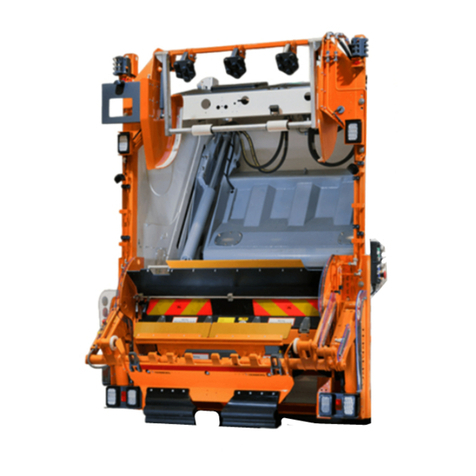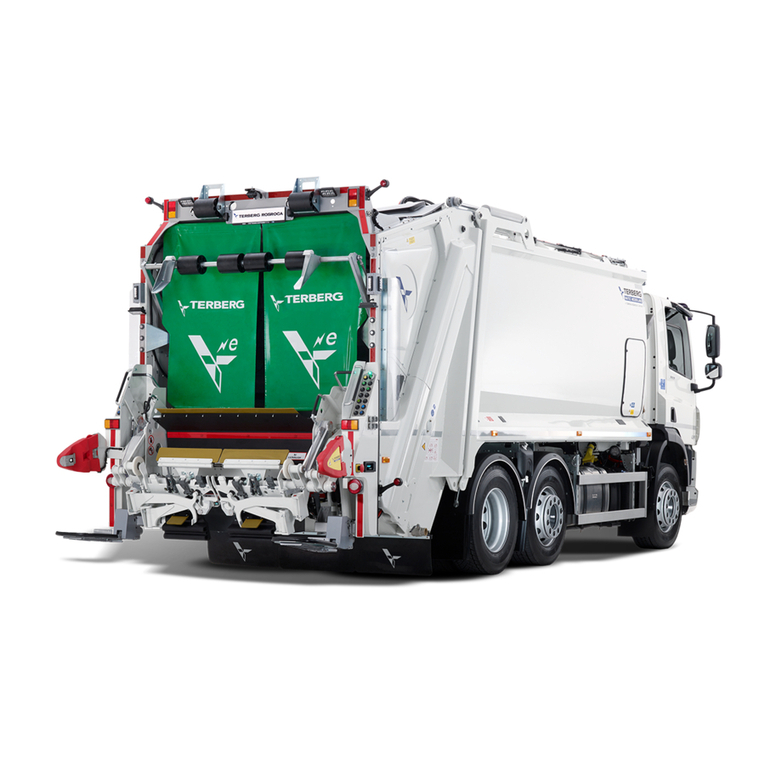
OREWORD
• General 3
• Guarantee 3
• Operator requirements 3
• Description of sections 3
• Symbols used 3
1. INTRODUCTION
1.1 Description of the bin lift system 4
1.2 Technical specifications Omni
DEL
&
Omni
DEL e
5
Bin and bin lift information 5
2. SA ETY
2.1 General safety instructions 6
2.2 Safety instructions applying while using
the bin lift system 6
2.3 Safety instructions applying during
maintenance and repair 7
2.4 Warning signs 8
3. TRANSPORT and STORAGE
3.1 General 9
4. INSTALLATION and COMMISSIONING
4.1 Dimensions of the bin lift 10
4.2 Assembly of the bin lift system on the
body of the refuse collection vehicle 13
4.3 Safety light screen (optional) 14
4.4 Coupling greasing system to a body
greasing system (optional) 14
4.5 Assembly advice footboards (optional) 15
4.6 Hydraulic connection Omni
DEL
16
4.7 Hydraulic connection Omni
DEL e
16
4.8 Electrical connection to compactor body
Omni
DEL
and Omni
DEL e
17
4.8.1 Explanation of cable loom connection pins 18
4.9 Battery connection Omni
DEL
e 20
5. OPERATING
5.1 Important components 23
5.2 Daily checks 24
5.3 Omni
DEL
( e) with “Teardrop” catcherbar
5.3.1 Loading 2-wheel bins 24
5.3.1.1 MANUAL loading 2-wheel bins,
capacity 80-360 litres EN 840-1
5.3.1.2 AUTOMATIC loading 2-wheel bins,
capacity 80-360 litres EN 840-1
5.3.2 Loading 4-wheel containers 26
5.3.2.1 Automatic 4-wheel container recognition
5.3.2.2 4-wheel containers with FLAT lid,
capacity 500, 660 and 770 litres EN 840-2
5.4 Omni
DEL
( e) with 2-position catcherbar
5.4.1 Loading 2-wheel bins 27
5.4.1.1 MANUAL loading 2-wheel bins,
capacity 80-360 litres EN 840-1
5.4.1.2 AUTOMATIC loading 2-wheel bins,
capacity 80-360 litres EN 840-1
5.4.2 Loading 4-wheel containers 29
5.4.2.1 Automatic 4-wheel container recognition
5.4.2.2 4-wheel containers with FLAT lid,
capacity 500-1280 litres EN 840-2
5.4.2.3 4-wheel containers with ROLL top,
capacity 770 and 1100 litres EN 840-3
5.5 DIN pick-up arms (optional) 31
5.6 Shake function 2-wheel bins (green waste) 31
5.7 Setting compacting 2-wheel bins (optional) 32
5.8 Single man trade 4-wheel containers 32
5.9 Semi-automatic function 4-wheel
containers (optional) 33
5.10 Loading bags / bulky waste 34
5.11 Travel height 34
5.12 Safety provisions 35
5.12.1 General
5.12.2 Emergency stop button
5.12.3 Resetting the emergency stop
5.12.4 Becoming trapped
5.12.5 Underwalk Protection evice (RP )
5.13 Diagnostic System 38
5.13.1 Home screen / messages
5.13.2 Monitor
5.13.3 Bin counter (optional)
5.13.4 Configuration
5.13.5 Settings
6. MAINTENANCE and CLEANING
6.1 General 48
6.2 Daily maintenance 48
6.3 Weekly maintenance 48
6.4 Maintenance: 6-weekly 50
6.5 Maintenance: annual 50
6.6 Maintenance: every 2-years 51
6.7 Maintenance schedule 52
6.8 Supplementary maintenance Omni
DEL e
53
7. DECOMMISSIONING (DISPOSAL) 54
8. APPENDICES
8.1 Electrical connections and components 55
8.2 Hydraulic connections and components 69
8.3 Special tools 74
8.4 Trouble shooting 75
Alarm messages 76
Spare parts book 101
2
ãTerberg Machines B.V. IJsselstein, The Netherlands
All rights reserved. No part of this book may be reproduced, stored in database or retrieval system, or published, in any form or in any way,
electronically, mechanically, by print, photoprint, microfilm or any other means without prior written permission from the publisher.
Contents
Page Page





























